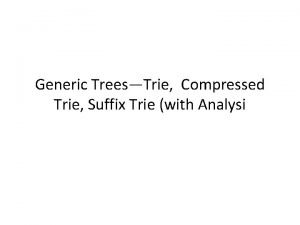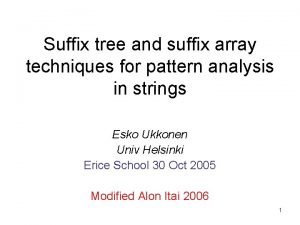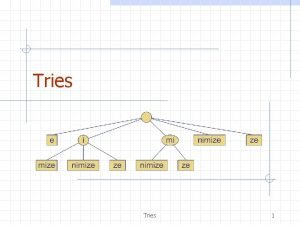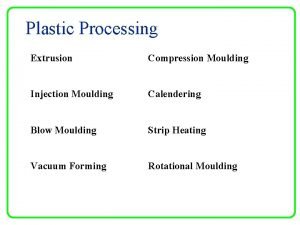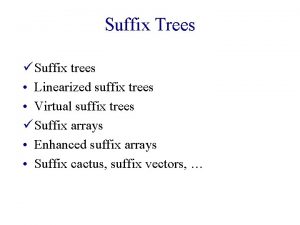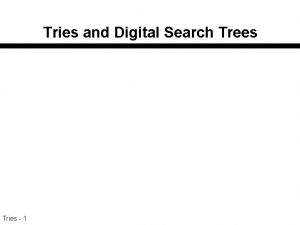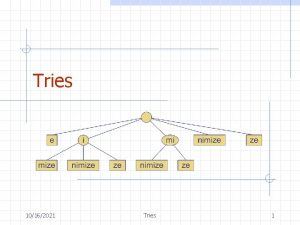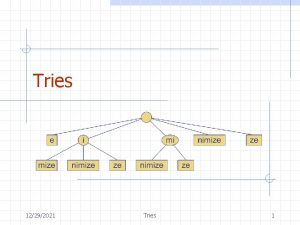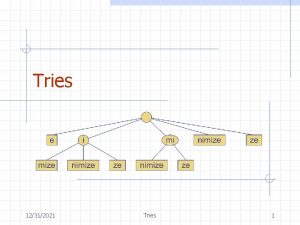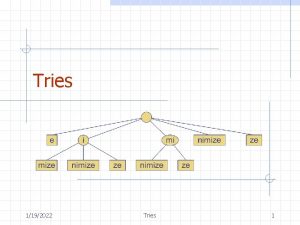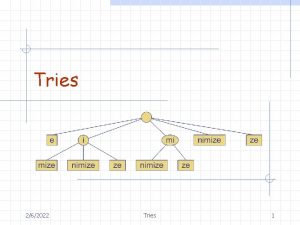Tries Standard Tries Compressed Tries Suffix Tries 1











- Slides: 11

Tries • Standard Tries • Compressed Tries • Suffix Tries 1

Text Processing • We have seen that preprocessing the pattern speeds up pattern matching queries • After preprocessing the pattern in time proportional to the pattern length, the Boyer-Moore algorithm searches an arbitrary English text in (average) time proportional to the text length • If the text is large, immutable and searched for often (e. g. , works by Shakespeare), we may want to preprocess the text instead of the pattern in order to perform pattern matching queries in time proportional to the pattern length. • Tradeoffs in text searching 2

Standard Tries • The standard trie for a set of strings S is an ordered tree such that: – each node but the root is labeled with a character – the children of a node are alphabetically ordered – the paths from the external nodes to the root yield the strings of S • Example: standard trie for the set of strings S = { bear, bell, bid, bull, buy, sell, stock, stop } • A standard trie uses O(n) space. Operations (find, insert, remove) take time O(dm) each, where: -n = total size of the strings in S, -m =size of the string parameter of the operation -d =alphabet size, 3

Applications of Tries • A standard trie supports the following operations on a preprocessed text in time O(m), where m = |X| -word matching: find the first occurence of word X in the text -prefix matching: find the first occurrence of the longest prefix of word X in the text • Each operation is performed by tracing a path in the trie starting at the root 4

Compressed Tries • Trie with nodes of degree at least 2 • Obtained from standard trie by compressing chains of redundant nodes Standard Trie: Compressed Trie: 5

Compact Storage of Compressed Tries • A compressed trie can be stored in space O(s), where s = |S|, by using O(1) space index ranges at the nodes 6

Insertion and Deletion into/from a Compressed Trie 7

Suffix Tries • A suffix trie is a compressed trie for all the suffixes of a text Example: Compact representation: 8

Properties of Suffix Tries • The suffix trie for a text X of size n from an alphabet of size d -stores all the n(n-1)/2 suffixes of X in O(n) space -supports arbitrary pattern matching and prefix matching queries in O(dm) time, where m is the length of the pattern -can be constructed in O(dn) time 9

Tries and Web Search Engines • The index of a search engine (collection of all searchable words) is stored into a compressed trie • Each leaf of the trie is associated with a word and has a list of pages (URLs) containing that word, called occurrence list • The trie is kept in internal memory • The occurrence lists are kept in external memory and are ranked by relevance • Boolean queries for sets of words (e. g. , Java and coffee) correspond to set operations (e. g. , intersection) on the occurrence lists • Additional information retrieval techniques are used, such as – stopword elimination (e. g. , ignore “the” “a” “is”) – stemming (e. g. , identify “add” “adding” “added”) – link analysis (recognize authoritative pages) 10

Tries and Internet Routers • Computers on the internet (hosts) are identified by a unique 32 -bit IP (internet protocol) addres, usually written in “dotted-quad-decimal” notation • E. g. , www. cs. brown. edu is 128. 148. 32. 110 • Use nslookup on Unix to find out IP addresses • An organization uses a subset of IP addresses with the same prefix, e. g. , Brown uses 128. 148. *. *, Yale uses 130. 132. *. * • Data is sent to a host by fragmenting it into packets. Each packet carries the IP address of its destination. • The internet whose nodes are routers, and whose edges are communication links. • A router forwards packets to its neighbors using IP prefix matching rules. E. g. , a packet with IP prefix 128. 148. should be forwarded to the Brown gateway router. • Routers use tries on the alphabet 0, 1 to do prefix matching. 11
